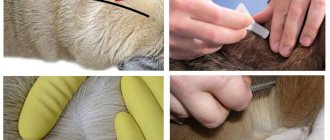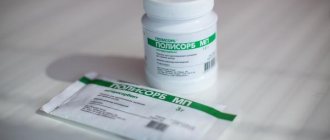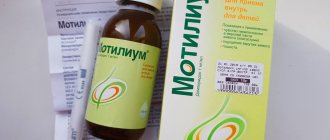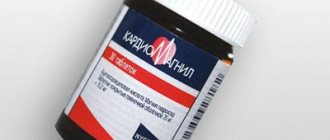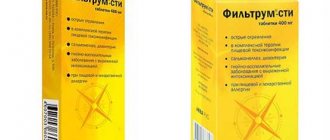Various means for combating harmful insects have become firmly established in everyday use. Some of them are used on a personal plot, while others are used in apartments and houses to exterminate cockroaches and cockroaches. The most common remedy for many years has been dichlorvos, which has found its application in many areas. Despite such popularity, not many consumers know what lies behind the familiar name and whether dichlorvos poisoning can occur.
What is dichlorvos
Dichlorvos is a well-known and effective means for killing various types of insects.
It contains organophosphorus compounds, which not only have a fatal effect on insects, but also harm human health, especially the nervous system. Dichlorvos (DDVP) has a number of advantages:
- Lightning-fast effect on various insects and mites;
- Three-way impact: direct contact, vapor inhalation and ingestion of poison;
- Do not belong to the group of highly toxic substances for their effects on humans and animals;
- Safe for the environment, highly degradable;
- Can be used close to indoor plants.
New generations of insecticides have recently been used to produce poisonous products against cockroaches, flies and other insects. DDVF was also modified; it began to be produced based on modern achievements in the chemical industry.
The disadvantages of the product include the following:
- Disgusting smell;
- Prolonged ventilation of the room after treatment with the drug;
- When using the product indoors, the person using it may become poisoned;
- In case of accidental ingestion, death is possible, since 2 grams of organophosphorus components are sufficient for this.
They first learned about dichlorvos in 1960. The Americans take credit for its discovery. Since foreign products were banned in the Soviet Union, Russian scientists quickly invented an analogue called “dichlorfors”.
The name fully corresponds to the original composition - dimethyl dichlorovinyl phosphate. In addition, the following components are added to the poison:
The modern toxic substance is very different from its ancestor. It is not so toxic and has a neutral odor. New products have appeared with additions to the name in the form of prefixes “Eco”, “Super” or similar abbreviations.
Depending on the country of origin and intended use, the composition of the product may vary.
What can poison a kitten?
Kittens are curious creatures and show interest in everything. However, even at home, a child faces various dangers. What causes animal poisoning? There are a number of factors that can provoke the development of poisoning.
- Food intoxication occurs as a result of consuming low-quality food and harmful waste. Digestive disorders are also possible when overeating. The stomach does not accept large amounts of food, but animals are not able to strictly control the amount of food.
- Poisoning in a kitten can be caused by house plants. What is safe for humans has negative consequences for animals. Some potted flowers disrupt the functioning of the cardiac and respiratory systems, leading to death.
- The curiosity of kittens has more than once become the cause of serious intoxication with household chemicals. Bright bottles attract attention, and for a small cat, one drop of the chemical is dangerous and can kill the animal.
- Inhaling chemical fumes is also dangerous. Antifreeze, fuel, solvents - these substances can disrupt the normal life of a kitten.
- Insect and tick repellents are also dangerous if used incorrectly. Flea drops can be used from a certain age if the dosage is observed. Flea collars should also be selected based on the age of the animal. For small kittens, it is better to comb out fleas yourself or use a gentle flea shampoo.
- Rat poisoning often occurs. Manufacturers make poison with an attractive smell that not only rodents like. Intoxication of a kitten by a poisoned mouse leads to the development of serious consequences, and death cannot be ruled out.
- Medicines also pose dangers. He can lick a bottle of medicine and swallow a pill. Some owners do not comply with the dosage when treating their pet, which also leads to intoxication.
- Another cause of poisoning is eating wild poisonous plants or herbs treated with pesticides.
Poisoning occurs in the absence of proper attention on the part of the owner, since a curious pet tastes everything. Toxins can enter through inhalation, through the skin and mucous membranes.
Who does this toxic substance help?
After obtaining this substance, scientists claimed that it quickly dissolves in the environment without causing any harm to it. This was attributed to the merits of the product. Further study of the drug revealed that the components of the drug remain active for a long time, causing great harm to the entire environment.
Nevertheless, dichlorvos is successfully used to destroy:
- Insects in the house (cockroaches, flies, bedbugs);
- Garden pests (whiteflies, caterpillars, spider mites, thrips and other pests);
- Parasites. When treating wheat grains with the product, their sterility is achieved; Fleas, ticks and other external parasitic insects in dogs, cattle and humans.
- Vernal insects in dogs, cats, livestock and people.
The components of the substance are able to penetrate the outer cover of insects, and also have a deadly effect when they enter the digestive system of parasites. Less effective exposure occurs when toxic fumes are inhaled.
The best results are observed when affecting crawling insects such as cockroaches and bedbugs. Spraying the substance on the surfaces along which parasites move ensures the penetration of the poisonous product through the outer shell of the pest and its neutralization.
Dichlorvos is produced in various variations:
- Aerosol;
- Concentrated;
- As an impregnation.
In our country, spray cans with a poisonous component are most often used - for home use and impregnation - in veterinary medicine. Typically, collars for dogs and cats intended to kill fleas are impregnated with the composition.
It is not so often that the component is added to special drops for application to the withers of the animal. Recently, in stores you can find special plastic strips impregnated with a poisonous composition. They are laid out indoors to repel or destroy parasites. Crawling through such barriers, cockroaches or bedbugs die within 24 hours.
Getting on the outer shell, the poison completely destroys the nervous system of the insect, which is why it immediately dies.
Nutrition and prevention
After any poisoning, it is necessary to review the kitten's diet. It is better to choose gentle food that does not injure the irritated stomach and intestines. In most cases, it is recommended not to feed the pet for a certain period of time, then the baby is provided with food three to four times a day.
During the first days the kitten is not given milk. Food includes porridge and low-fat foods. Portions should be small, food should be warm. After a week, you can return to your normal diet. It is possible to avoid intoxication in a kitten by following simple preventive measures.
- Monitor your pet’s movement and do not allow it into places where food waste accumulates;
- When baiting rodents, send them to another room or place of residence;
- Use flea and tick products with extreme care;
- Medicines and household chemicals are placed in places inaccessible to the baby;
- On the street they make sure that the small pet does not eat poisonous plants;
An attentive owner will try to prevent poisoning from occurring. Poisoning in a kitten leads to organ dysfunction and can cause death. Compliance with prevention and attentiveness will help protect your small pet from unpleasant consequences.
Basic rules for using the product
The most harmless are specially treated plastic strips with dichlorvos. They are not often found on store shelves, so the population prefers to use spray cans.
A concentrated substance is more suitable for industrial use, since the product is very toxic and must be diluted and stored in a safe place.
The manufacturer recommends spraying the toxin in the intended habitats of insects or where they like to crawl at night. If we are talking about cockroaches, these are kitchen tables; if we are talking about bedbugs, these are dark, dirty places or crevices. During the day, the parasites are not very active, so finding their “rookery” will not be difficult.
No matter how they say that poison does not have a negative effect on humans, this is not so. Dichlorvos is a poison that can poison not only unwanted insects, but humans and domestic animals.
Therefore, when using the drug, it is necessary to take certain safety measures:
- Remove dishes, clothing, personal hygiene items and food from the area being treated;
- Children, pets and unauthorized persons should not be in the treatment area;
- The person spraying the drug must wear closed clothing, cover his hair, protect his face with a mask or respirator, and his hands with gloves;
- You cannot enter the premises for several hours;
- After the waiting time has ended, the room must be well ventilated for at least one hour. Only after this can people and animals return to it;
- Before coming into contact with any surfaces, they must be thoroughly wiped with soapy water.
It is unacceptable for the poison to come into contact with the mucous membranes of the mouth, nose or eyes. If this happens, they should be rinsed thoroughly with water. During treatment, you should absolutely not drink, smoke or eat. After the procedure is completed, outer clothing is removed and cleaned. Exposed areas of the body and hands are thoroughly washed. It is advisable to rinse your mouth with water.
When purchasing a drug, you should pay attention to its composition, expiration date and the parasite it is intended to destroy. Recently, manufacturers have been producing dichlorvos not only with a broad spectrum of action, but also for the destruction of a specific insect.
Symptoms and causes of poisoning
- Refusal to eat;
- Lack of activity, apathy, lethargy;
- Nausea, vomiting;
- Diarrhea;
- Increased salivation.
Poisoning by various substances is characterized by the presence of certain signs. It is recommended to pay attention to them to detect the cause of intoxication.
- Changes in the functioning of the nervous system;
- Drowsiness, lethargy or agitation;
- Large pupils;
- Change in color of mucous membranes;
- Loss of coordination;
- Strong flow of saliva;
- Vomiting with mucus;
- Diarrhea with bloody inclusions;
- Swollen abdomen, touching it causes pain;
- Apathetic, sluggish state;
- Problems with gait;
- State of paralysis;
- Convulsive manifestations;
- Visual impairment;
- Reduced body temperature;
- Urge to vomit;
- Diarrhea;
- Respiratory dysfunction;
- Swelling of the mucous membranes;
- Convulsions;
- Apathy;
- Refusal of food and water;
- Constant meowing;
- Vomit;
- Severe diarrhea;
- Apathy, lack of playfulness;
Worm intoxication also causes discomfort and signs of poisoning. Kittens have a bloated stomach, loss of appetite, and weight loss. The baby's condition is constantly deteriorating.
In some cases, poisoning does not show any symptoms and lasts for a long time. Such conditions are dangerous due to the lack of symptoms, because they do not allow treatment to begin on time.
The danger of dichlorvos
The composition of the aerosol can may vary depending on the manufacturer, but the main toxic component is always present. Therefore, the substance belongs to the third level of toxicity in relation to humans.
If a substance is low toxic, this does not mean that it cannot be poisoned. This happens in cases of violation of safety measures or use of the toxin for other purposes. If you stay indoors after spraying the composition, you can get seriously poisoned.
Toxins will enter the bloodstream, swelling of the nasopharynx and respiratory tract is possible. If a person is prone to allergic reactions, an attack of suffocation is possible.
Dichlorvos is especially dangerous for cats. They do not have a large body weight, so the concentration of the toxic substance in their blood can be very high. As a result, the animal dies or gets serious liver disease.
In case of poisoning by vapors of the substance or its accidental entry into the esophagus, severe headache, dizziness and fever up to 39 degrees may occur. In addition, signs of an allergic reaction may occur:
- Runny nose;
- Dry cough;
- Swelling of the larynx and nose;
- Skin rashes accompanied by itching and burning.
With a small concentration of poison in the blood, the symptoms go away on their own within a few days.
Dichlorvos is an old and proven remedy for killing unwanted insects. If used correctly, it will not harm either humans or pets. And harmful insects will leave the house for a long period.
First aid for kitten poisoning
If unpleasant symptoms are detected in an animal, it is necessary to provide assistance at home and call a veterinarian. Before the doctor appears, you should perform actions that can cleanse your small body of toxins. What to do at home if a kitten is poisoned?
- Stop contact with the poison. If poisoning occurs due to the toxin getting into the hair and skin, then you need to thoroughly rinse the area with water. In case of poisoning with dichlorvos or other chemical gases, the animal is taken out into fresh air.
- If the pet is poisoned by food, the stomach is washed with a weak solution of potassium permanganate. The procedure is prohibited in case of poisoning with acids, alkalis, in the absence of consciousness in the animal and if the kitten is already burping.
- Then sorbents are used to speed up the removal of the toxin from the body.
- Poisoning caused by an insect bite - the parasite is removed, the wound is washed with warm water.
- If you have heart problems, you can give the animal a couple of drops of Corvalol. Half a crushed nosh-pa tablet will help you cope with the pain.
- Rehydron solution, lightly salted liquid, or rice broth can help avoid dehydration. Liquid medicine is given by spoon or syringe.
After first aid is provided, the kitten is taken to the veterinarian. Simple treatment can be continued at home, provided the condition does not worsen.
Types of "Dichlorvos"
Active ingredients that may be part of modern “Dichlorvos”:
- permethrin (in more potent modifications - Vaportrin or Lambda-Cyhalothrin);
- cypermethrin;
- tetramethrin;
- piperonyl butoxide;
- diethyltoluamide;
- dimethyl sulfoxide.
All types of the drug have an intestinal contact effect. The product does not leave marks on furniture. “Dichlorvos” is produced in the form of sprays, aerosols, and is also packaged in 10 ml dropper bottles, propellant-free cylinders with a spray of 500 and 1000 ml, and canisters with a volume of 1 to 10 liters.
- “Dichlorvos Universal”, “Dichlorvos Super” - the most potent product, characterized by a sharp unpleasant odor;
- “Dichlorvos Varan” is a potent drug with a lemon aroma;
- “Dichlorvos Eco” is an effective but quickly eroding product, scented with lavender;
- "Dichlorvos Neo" is the least allergenic drug from the entire line. There are no fragrances in the composition, the unpleasant odor is barely noticeable and quickly disappears. The product can be used to combat parasites of domestic animals.
When choosing Dichlorvos, you need to take into account that a floral or fruity aroma only camouflages the unpleasant odor of the insecticide. Therefore, for people with hypersensitivity to odors, Dichlorvos Neo is suitable as the lesser evil.
When is a vet needed?
You should consult a doctor for any type of poisoning. The doctor will examine the animal, conduct the necessary examinations and select appropriate medications. If possible, it is recommended to bring with you the substance that caused the poisoning, vomit. Be sure to talk about the symptoms that arise and the actions taken.
It is necessary to visit a doctor if the kitten’s condition does not improve and the symptoms develop intensively.
In severe cases, treatment is carried out in a hospital, specific procedures and droppers with medicinal solutions are prescribed. Surgical interventions are not excluded.
The use of "Dichlorvos" in the apartment
With the help of Dichlorvos you can get rid of almost any domestic pest, but the fight against each species has its own characteristics.
Destruction of cockroaches and ants
It is best to get rid of cockroaches or ants in several neighboring apartments at once. If this is not possible, you should at least notify your neighbors about the day of the persecution so that they close doors, windows, and ventilation ducts through which fleeing insects can enter.
The best option for the kitchen is “Dichlorvos Neo”: its faint odor quickly disappears. But if the parasite population is large, use “Universal”, “Super” or “Varan”.
Instructions:
- Put all food in the refrigerator.
- Remove indoor plants from the kitchen.
- Deprive cockroaches of access to water (thoroughly wipe the sink, the area near the pipes, close the toilet).
- Remove the dishes from the kitchen or cover them with plastic wrap.
- From a distance of 25–30 cm, thoroughly spray with Dichlorvos the baseboards, crevices where cockroaches and ants hide, and all surfaces on which they move. In the bathroom, sort out the dirty laundry, treat the basket and cabinets with the preparation (after protecting personal hygiene products from toxic splashes).
- Leave the apartment and not return there for 2-3 hours.
- When you return, open the windows and ventilate the rooms for 1.5–2 hours.
- Do wet cleaning, wash dishes and shelves in cabinets.
"Dichlorvos" is effective for 14–15 days. Therefore, if there are no animals in the house, baseboards and other surfaces that people do not touch do not need to be washed. The drug does not harm the eggs, so to completely defeat the parasites, “Dichlorvos” from cockroaches and ants will have to be applied 2-3 times with an interval of 2 weeks.
Destruction of bedbugs
Before baiting bedbugs, you need to warn your neighbors. The favorite place of parasites is a bed or sofa, but insects do not disdain old furniture. To treat upholstered furniture that absorbs odors for a long time with “Dichlorvos” against bedbugs, “Neo” is usually used, but “Eco” or “Varan” are also suitable for cabinets.
It is necessary to treat the front and back of the sofa cushions, mattresses, cabinets inside and outside (including the back walls) with the preparation. Regarding ventilation and subsequent cleaning, the rules are the same as when baiting cockroaches. Using Dichlorvos for bedbugs, you can exterminate only adult bedbugs. To get rid of insects that gradually hatch from eggs, the procedure must be repeated several times at 2-week intervals.
Destruction of fleas
Fleas settle near the sleeping area, but before you start exterminating them, you should free your pets' fur from parasites. Although the instructions for Dichlorvos Neo mention that it is allowed to be used for this purpose, in practice the product is used for cattle and farm animals. The delicate skin of cats and dogs can break out in rashes due to too much pyrethroid dosage. Therefore, it is recommended for pets to buy one of the special veterinary products containing pyrethroids in lower concentrations.
Carpets, mattresses, sofa cushions, and pet bedding are sprayed with Dichlorvos on both sides. Then proceed in the same way as when baiting other crawling insects.
Destruction of flies, midges, mosquitoes
When fighting flying insects (except moths), first treat the areas of their highest concentration, and then spray Dichlorvos in the air. The apartment is left closed for 2–3 hours, then ventilated and wet cleaned.
Moth control
When killing moths, it is very important not to spoil fur outerwear. It is ventilated on the balcony (moth larvae cannot tolerate bright light). In the meantime, the inner surface of the cabinets is treated with Dichlorvos Neo. A large piece of white cloth is generously sprayed with the drug. After hanging the clothes in the closet, cover them with this material. Fur items will be simultaneously protected from moths and freed from direct contact with the drug, so they will not absorb the smell of Dichlorvos. Before placing in bags, woolen clothes can be wrapped in dry paper treated with the drug.
After laying the clothes, spray the cleaned carpets with Dichlorvos, leave them indoors for several hours, then ventilate them.
Lice control
Theoretically, Dichlorvos works well against lice, but in practice it can cause irritation of the scalp and hair loss. The drug is not toxic to nits, so to get rid of lice you would have to treat your head several times.
To destroy lice, Dichlorvos Neo is used only as a last resort, if there is no other remedy (even kerosene is healthier for hair). A plastic bag is placed over the head, into which an aerosol has previously been sprayed. Press the bag on top with a warm scarf or towel. After 30–40 minutes, you need to wash your hair and comb out the dead insects. After baiting lice with Dichlorvos, the scalp and hair need a softening mask with olive or castor oil and aloe juice.
How to treat a kitten after poisoning
- Three hours after the sorbent preparations, give the baby a little vegetable oil or saline laxatives. This will speed up the process of removing toxins from the intestines.
- It is allowed to give the cat an enema with saline using a small syringe.
- Diuretics normalize kidney function; for this purpose it is better to use herbal preparations.
- Be sure to ensure your baby is properly hydrated to avoid dehydration.
- To maintain liver function, give the kitten a quarter of a Karsila tablet.
Treatment with medications must be coordinated with a veterinarian; independent use of medications can provoke negative consequences.
"Dichlorvos Neo" for the treatment of pets
“Dichlorvos Neo” is used to treat cattle, pigs, and sheep to rid them of ticks, flies and horse flies. The drug is sprayed on stalls (including for newborn calves and foals), doghouses, and sprayed in feed kitchens, artificial insemination points, and pens in summer camps.
The drug in dropper bottles is used as an external agent for the treatment of:
- psoroptosis in sheep (spray the entire body of a pre-shorn animal);
- psoroptosis in rabbits;
- scabies and demodicosis in pigs and cattle;
- pediculosis in minks (pregnant females are treated no later than 2 weeks before whelping);
- demodicosis in dogs, notoedrosis in cats (to prevent the animal from licking toxic substances, put a cardboard circle around the neck for 15 minutes or fix the jaws with a loop of braid);
- otodectosis in cats, dogs, fur-bearing animals.
Small blood-sucking insects are unwanted guests in our homes. Will Dichlorvos help against bedbugs, how effective will it be, what do reviews from users say? It is also important to find out whether different brands of dichlorvos differ in composition and effect. Read about all this in this article today.
Carbamates
Currently, a significant number of carbamates with insecticidal properties have been studied. Dicresyl has been well studied in the Soviet Union.
Dicresyl . White and slightly pinkish crystalline substance with a slight cresol odor. Insoluble in water, soluble in some organic solvents - benzene, acetone, alcohols, etc. Dust and emulsion are prepared from diresyl. Effective in the fight against certain types of synanthropic insects. Equal in effectiveness to chlorophos. Thus, the minimum concentration of the emulsion that ensures 100% death of housefly larvae is 0.2% (1 l/m2). The minimum dose of the drug to ensure the death of bedbugs and cockroaches is 0.5 g/m2. Dicresil is moderately toxic to warm-blooded animals. For example, when administered orally, the LD50 for mice is 630 mg/kg.
Does Dichlorvos help against bedbugs?
Dichlorvos is a potent agent that in most cases leads to the immediate death of parasites. But to completely get rid of insects, one treatment of the room is not enough. If the colonies are numerous, the manufacturer recommends repeating the aerosol spray every 10 days for 1-2 months.
Compound
The composition of Dichlorvos, which our grandmothers used, included the organophosphorus compound Dimethyldichlorovinylphosphate. But science does not stand still and modern drugs are produced based on synthetic pyrethroids.
They are less toxic to humans, the period of action on the parasite is longer, but they also have significant disadvantages. For example, with prolonged use they cause addiction in insects.
Most often, modern dichlorvos uses permethrin, cypermethrin, tetramethrin or combinations of these substances. Combining insecticides allows insects, including bedbugs, to become non-addictive.
The concentration of the active substance varies depending on the manufacturer.
How does Dichlorvos work against bedbugs?
The principle of action of the insecticide is determined by the active substance. It blocks the transmission of nerve impulses, causing paralysis and death of the pest.
The maximum impact is achieved when the chemical comes into direct contact with the body of the bug. The residual effect of the insecticide sprayed on furniture and household items continues for another 2-3 weeks.
You need to understand that bedbugs, unlike cockroaches, do not eat leftover food, but only drink human blood. Therefore, to destroy them, the most extensive treatment of the premises and all crevices is necessary. If Dichlorvos does not fall directly on the bug, the likelihood of its death is very low.
Since the current Dichlorvos has undergone changes in composition and contains different components than its Soviet counterpart, it is difficult to call the drug potent. To completely free your home from bedbugs, at least a month of regular, proper treatments is required.
It is especially difficult with bed bugs (see their photos). It is necessary to treat not only furniture with insecticide, but also things, bed linen, followed by washing and ironing.
Is it possible to kill bedbugs with Dichlorvos?
Yes, you can, but be prepared that you will have to spend 1-2 months of weekly treatments of the room.
When purchasing modern Dichlorvos, each of us wonders whether it helps and is effective against household pests. There are conflicting opinions on this matter. Most users who remember the Soviet insecticide claim that the modern analogue is not as effective. Whether bedbugs are afraid of Dichlorvos depends on the brand of the manufacturer and whether the instructions are followed correctly.
Of course, if the substance gets on the body of the bug, the insect dies. But if direct contact with the pesticide does not occur, the pest can survive. To destroy the remaining individuals, several repeated treatments will be required.
You must understand that the poison in Dichlorvos does kill the bug, but it will only kill it if it gets on it.
It is also important to understand that bedbugs hide very well and you may not even suspect where they have settled and may not treat these places.
These factors complicate the process of getting rid of parasites at home.
If you are serious about killing bedbugs with Dichlorvos, prepare for a long battle and constant treatment of the room. Don't give the insect even a chance. And only then will you do it.
Does Dichlorvos kill bedbug eggs?
The toxicity of Dichlorvos is not enough to kill insect eggs. The product only affects adults and larvae and cannot destroy the shell of the eggs. After a couple of weeks, a new generation of pests emerges from them.
To completely get rid of bedbugs, you need to prevent the larvae from reaching adulthood. To do this, repeat spraying the aerosol every 10 days.
Why doesn't Dichlorvos kill bedbugs?
Sometimes users are faced with the fact that the insecticide does not kill pests:
- Make sure the pesticide is not expired. Perhaps the storage conditions or instructions for use were violated.
- Perhaps you previously treated the room with similar substances and it became addictive to bedbugs, that is, it does not affect them.
- Another important reason why the poison does not affect insects. As stated earlier, it is very important to prepare yourself for a serious fight with the pest. The bug is one of those insects that is practically impossible to remove at one time.
It requires constant, painstaking work, day after day, for a month or two. If you want to do it all in one go, the hot or cold mist method will work for you.
Are there any complications?
Often, entry into the body through the respiratory tract or skin does not pose a great danger; symptoms disappear within a short period of up to three days. But more serious consequences are possible when an individual organism is intolerant to any component of the drug or with prolonged contact. In such cases, you can notice obvious intoxication of the body.
In severe poisoning, paroxysmal coughing, increased blood pressure, increased cardiac activity, and repeated vomiting are observed. If spasms of internal organs and convulsive syndrome appear, these are the most dangerous signs. If any are present, collapse may occur, and perhaps even a coma will develop.
In case of dichlorvos poisoning, you need to get help in a timely manner.
What to do if you are poisoned by a gaseous substance?
In case of vapor intoxication, it is necessary to immediately remove the victim to fresh air. It is necessary to rinse your mouth with a solution of water and baking soda or clean warm water. To minimize the harm of the toxin, you should also wash exposed areas of the body and change into clean clothes, then provide bed rest.
If the toxin ends up in the stomach, you should definitely induce vomiting, take sorbents, and then take magnesia, Glauber’s salt, or any saline product with a laxative effect within an hour and a half.
What to do if the toxin gets into your eyes or skin?
If the substance gets on the skin, it is necessary to remove it with a cotton pad, the main thing is to avoid rubbing it into the skin, otherwise the harm will only increase. Then treat the affected area with a solution of ammonia (5–10% is enough). In case of contact with the eyes, rinse them with warm, clean water, and then drip a few drops of albucid.
How to treat an apartment against bedbugs with Dichlorvos?
Insects must be poisoned according to the instructions. Carry out the treatment wearing personal protective equipment, avoiding contact of the chemical with the mucous membranes. When spraying a pesticide indoors, try not to inhale the aerosol. With prolonged exposure to the insecticide on the human body, signs of poisoning appear in the form of nausea and dizziness.
Let's look at how to properly poison bedbugs with Dichlorvos:
- Wash the floors, remove the carpets, after vacuuming them.
- Move furniture and remove fabric coverings from sofas and chairs.
- Place clothes and bedding in large sealed bags.
- Close windows and doors, cover cracks and electrical sockets with cling film.
- If there are pets in the house, take them out. Cover the aquarium or terrarium with a blanket.
- Wear personal protective equipment.
- Shake the aerosol can.
- Treat all places where pests can live: baseboards, furniture, cracks, floors, walls, ceilings. Hold the can at arm's length at a distance of 20 cm from the surface to be treated.
- Leave the room closed for at least 2 hours.
- Ventilate the rooms and wash thoroughly.
Here are the places that should be treated first:
How to treat clothes?
Bedbugs love to live in sofas, beds, and bedding. There is an important rule: under no circumstances should the drug be sprayed into areas that come into contact with the skin. For example, on blankets, bedspreads, sheets and pillows.
Effect on the human body
Dichlorvos, as mentioned above, being one of the derivatives of chlorophos, belongs to the classical organophosphorus compounds, so it can be very dangerous for humans.
Depending on the state of aggregation, the routes of penetration of the substance into the body may be the respiratory tract , digestive organs, and in rare cases, prolonged surface contact. Modern toxicological grading classifies drugs into the third hazard class with a moderate risk to the health and life of the victim of poisoning.
The basic principle of the pathological influence is inhibition of cholinesterase activity , which in turn provokes excessive excitation of synaptic choline-reactive structures. At very high concentrations, dichlorvos has a direct negative effect on the central nervous system and brain, penetrating the blood-brain barrier.
Another feature of dichlorvos is its short duration of action with high initial toxicity.
It does not accumulate in the body, and there is also no mutagenic or teratogenic effect, which is explained by the relatively rapid elimination of the substance from the body through classical metabolism.
Which Diflofos is best for bedbugs?
The instructions for using anti-bedbug products are approximately the same. Pest control is carried out indoors by spraying a pesticide on all places where insects can live.
However, the effectiveness of the product largely depends on its composition and manufacturer. Let's consider which Dichlorvos is the best.
Dichlorvos Neo odorless against bedbugs
The insecticide is produced by Arnest. The drug is recognized as potent. It contains synergists - insecticides that enhance the penetration of poison into the insect's body.
Read the article for a detailed description and instructions for Dichlorvos NEO. The chemical acts by contact. As a rule, an unscented aerosol is produced, but there are also products with lemon and mint flavors. Several treatments are required to kill bedbugs.
Reviews of Dichlorvos Neo are mostly positive. If the drug comes into contact with a pest's body, it causes paralysis and death. In the absence of contact, insects can survive.
We recently bought an apartment in a five-story building. The previous owner neglected it, and there were bedbugs in the cracks and furniture. Before the renovation, we decided to get rid of unexpected guests. We treated all the cracks with Dichlorvos. Half of the bedbugs came out and died immediately. We processed it 3 more times while the repairs were being made. When we moved in, there were no more insects.
Clean house
The product is available in the form of an aerosol. It is based on cypermethrin and tetramethrin - natural insecticides that are harmless to humans. But for this reason, Dichlorvos Clean House cannot be called highly effective. Natural compounds quickly lose activity when exposed to ultraviolet radiation.
The pesticide penetrates the chitinous membrane of the insect and causes paralysis. However, it does not affect eggs, so several treatments are required every 2-3 weeks to get rid of pests. User reviews show that it is possible to completely get rid of insects only in combination with powdered bedbug repellents.
Varan A
The chemical is produced by the Russian company Sibiar. This is a proven remedy that can rightfully be called highly effective. It contains natural and synthetic pyrethroids.
What types of Dichlorvos Varan are there and how they differ, read the article.
The residual effect of the insecticide lasts 2-3 weeks. But to completely get rid of bedbugs, you will have to spray the aerosol on the walls and furniture every 10 days 2-3 times.
Dichlorvos Eco
The chemical is produced by Arnest. The product contains several pyrethroids, as well as chamomile extract and lavender flavor. Thanks to additional ingredients, the pesticide repels bed bugs.
Despite its complex composition, it cannot be called a highly effective product. Users claim that after the first treatment, the number of insects is slightly reduced. To completely destroy them, it is sometimes necessary to resort to additional poisons.
Dichlorvos Extra
The insecticide is produced by the Thunder company. Contains several pyrethroids. The product has a strong odor, so use it as quickly as possible and only with a respirator.
Despite the strong odor and toxicity, Dichlorvos Extra is ineffective. It does not destroy all insects at once, so several treatments of the room are required. In addition, the bottle is not very convenient for spraying, so the insecticide often gets past the place where the stream is directed.
Price – 100-150 rubles.
Bed bug raid
This is a universal insecticide based on 2 pyrethroids: cypermethrin and prallethrin. Bed bugs develop resistance to the latter, so the drug cannot be called effective. In addition to the above components, the composition includes imiprotrin, a substance that enhances the effect of the two previous compounds.
The raid works well with minor contamination of the premises. The disadvantages of the chemical include a heavy odor, which the fragrance does not mask very well, and a cloudy film that forms on the surface after spraying.
Combat
Chemicals for bedbugs are available in the form of aerosols of 2 types:
- Super Spray and Super Spray Plus. Narrowly targeted remedies for bed bugs. They contain cyphenothrin and imiprotrin. Penetrating through the chitinous cover, the substances cause paralysis of the nervous system and affect the gastrointestinal tract of the insect.
- Multispray is a pesticide with a wider spectrum of action. It contains tetramethrin and permethrin.
Despite their high efficiency, poisons do not destroy pest eggs. The cost of such Dichlorvos is higher than that of other brands. After the room is ventilated, the effect of the insecticide stops.
Dry Dichlorvos for bedbugs
Dry Dichlorvos has average effectiveness. It affects the insect only when the latter comes into contact with areas treated with a pesticide. Among the disadvantages of this form of release are an unpleasant odor and the possibility of poisoning pets.
Dry Dichlorvos is best used to consolidate the result after using the aerosol. It has a prolonged effect and fights larvae born from eggs. This type of drug protects the home from subsequent generations of insects.
Price – 80-100 rub.
Chlorinated hydrocarbons
Hexachlorocyclohexane (HCCH, hexachlorane, etc.) . The technical preparation is a crystalline substance, soluble in organic solvents, and is a mixture consisting of eight isomers (alpha, beta, gamma, delta, etc.). High insecticidal properties are inherent only in the gamma isomer, of which hexachlorane contains approximately 8–11%. Technical hexachlorane has an unpleasant, long-lasting odor reminiscent of mold. Hexachlorane is highly toxic to insects. So, for example, for cockroaches its toxicity is 4.6 μg per 1 g of insect body weight, for adult stages of flies - 0.8 μg, and for newly fledged flies - 0.4 μg.
Hexachlorane acts by contact, but has an intestinal and strong fumigation effect. It is moderately toxic for warm-blooded animals. The death of mice is observed at a dose of 1 g/kg. The industry produces: 15% emulsion concentrate (prepared from enriched hexachlorane containing 23% gamma isomer), 6 - 12% dust, 3% insecticidal soap. Given the high volatility of hexachlorane, it is not used in residential premises, for impregnation of linen, or in food factories.
Gamma and isomer of hexachlorane (lindane) . In its pure form – colorless crystals, practically insoluble in water (dissolves up to 10 mg/l); soluble in organic solvents; almost odorless. Highly toxic to arthropods. So, for example, the average toxic concentration is: for ticks - 0.024%, bedbugs - 0.02%, lice - 0.025%, fleas - 0.018%, flies - 0.006%. When the drug is applied to the pronotum of mosquitoes, 50% of insects (LD50) die from a dose of 0.0005 mcg per insect, LD50 for flies is 0.046 mcg. For animals, the LD50 is 125 mg/kg. The gamma isomer has a fumigation effect. Included in combined dusts, aerosol cans and other forms.
